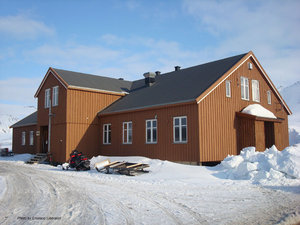CNR Arctic Station “Dirigibile Italia”

Address
CNR Arctic Station 'Dirigibile Italia'9173 Ny-Ålesund
Svalbard
Station manager
Mauro MazzolaE-mail: mauro.mazzola@cnr.it
Contact Station
Phone: +39 06 499372331 – 332E-mail: luigipaolo.dacqui@cnr.it
http://www.isp.cnr.it/index.php/en/
Station Features
Opening year: 1997 Status: OpenFacilities
Station name and owner
CNR Arctic Station “Dirigibile Italia” is the Italian scientific station in Svalbard. It is funded and managed by the National Research Council of Italy (CNR).
Location
<p>The station is located in Ny-Ålesund, on the shores of Kongs­fjorden, on the west coast of Spitzbergen, the largest island of the Svalbard archipelago. Ny-Ålesund was a mining village until 1963. During the 1990’s it transformed into a multidisciplinary science settlement, and today stations from 10 different nations host researchers from up to 20 different countries. The area around the village is geographically diverse, including the fjord with several islands, a plateau, alluvial plains, mountains with large glaciers and extensive moraine systems, glacial rivers, coastal lagoons, and a small lake. The area further includes ornithological reserves and a nature reserve with regulated access.</p>
Climate data
Grey colours are WMO Climate Normals including maximum and minimum values. Blue colours are individual years.
Climate data for the stations where extracted via Copernicus Climate Data Store, from the global gridded reanalysis product: ERA5 monthly averaged data on single levels from 1940 to present. Description and source code: Roemer J.K. 2023. https://doi.org/10.5281/zenodo.10214922 Data Source: Hersbach et al. 2023. Copernicus Climate Change Service (C3S) Climate Data Store (CDS), https://doi.org/10.24381/cds.f17050d7
Biodiversity and natural environment
Ny-Ålesund enjoys the mildest climate at this latitude due to a distant branch of the Gulf Stream bordering the west coast of Spitzbergen. The fauna is dominated by a large variety of birds, including arctic terns, auks, kittiwakes, gulls, barnacle geese, northern fulmars, Svalbard ptarmigans, and Arctic skuas. Mammals include Svalbard reindeer, arctic foxes, and a sporadic presence of polar bears, also seals and less frequently whales, are spotted in the fjord. The permafrost is continuous and 75-450 m thick, and the active layer thickness ranges between 0.3 and 3.8 m. The whole area lies within the Dryas octopetala zone of the high-arctic fell-field vegetation.
History and facilities
The Station was established in 1997. It provides accommodation for seven persons in single and double rooms. Also, laboratories with basic equipment are available at the station. A 32 m high ‘Admundsen-Nobile Climate Change Tower’ belongs to the station, and is equipped with instruments investigating energy budget and flux exchanges at the atmosphere-land interface. In addition, the ‘Gruvebadet Laboratory’ for sampling aerial pollutants and particles is part of the station’s facilities. The station has a membership in the Ny-Ålesund Marine Laboratory consortium, an experimental laboratory for research in marine ecology, physiology, and biochemistry.
General research and databases
Research programmes currently developed at the station deals with microbial ecology and evolution; biogeochemistry and energy fluxes; vegetation and permafrost studies; oceanography, marine biomarkers; atmosphere, aerosols, gases and clouds; remote sensing of the environment; sun-earth relations and space weather; human biology and medicine.
Link to data: https://dataportal.eu-interact.org/stations
Station Monitoring
Human dimension
11 permanent stations are established in Ny-Ålesund by 10 different countries and the entire settlement is owned and operated by the Norwegian State owned company King’s Bay AS. Researchers from many countries regularly come to Ny-Ålesund to work. King’s Bay AS provides and manages all necessary infrastructures and services in the community including meals, maintenance of buildings and roads, post office, local shop, airport, and harbour. Research is coordinated by the Ny-Ålesund Science Managers Committee (NySMAC) and the Svalbard Science Forum (SSF).
Access
Regular flights between Ny-Ålesund and Longyearbyen take place four times per week in summer and twice per week in winter. There is an international airport in Longyearbyen with scheduled connections to mainland Norway. Ny-Ålesund can be reached also by boat. Sailing in the fjord is possible for people at the station through agreements with the Sverdrup Station of the Norwegian Polar Institute and with King’s Bay AS. In winter and spring snowmobiles are available for field trips. In summer, hiking is the only mean of transport in the field outside the village.

